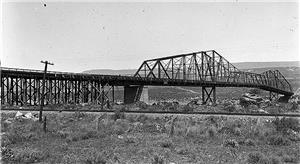In 1908, the first highway bridge to span the Columbia River opens at Wenatchee. The privately owned bridge carries people, horses, wagons, and a rare motorcar, and also water in two large pipelines along its sides. It connects Chelan County on the Wenatchee shore with Douglas County on the eastern shore (now East Wenatchee), and opens Douglas County to apple orchard development. It is a 1,060-foot pinconnected steel cantilever bridge and costs $177,000 to build. It will carry the Sunset Highway (State Road No. 2, later also U.S. Highway 2 and redesignated Primary State Highway 2) across the river after that highway opens in 1915. In 2011 it will still be used as a footbridge and will be the oldest extant steel cantilever bridge in Washington.
The bridge was the brainchild of W. T. Clark, one of the builders of the Highline Canal, a major irrigation project to water the apple orchards in the valley. It was financed in part by James J. Hill (1838-1916), of the Great Northern Railway (which arrived in Wenatchee in 1892). In its second year of operation the canal firm that owned it decided to start charging tolls.
This prompted town leaders to hasten to the state legislature to persuade the state to purchase the bridge as part of the state highway system. The state purchased the bridge despite the state-employed consultant's opinion "that the ugliness of the structure is very apparent" (Dorpat), despite defects in the timber floor and concrete piers, and despite leaks in the waterpipes.
The structure remained in full use until 1950 when a new highway bridge was built. In 2011 it was still in use as a footbridge and still carried water to the apple trees of East Wenatchee.

